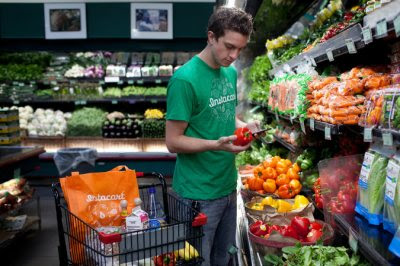The retail food shopping
experience is evolving faster than many legacy CPG manufactures; grocery
retailers can even begin to image according to Steven Johnson Grocerant Guru®
at Tacoma, WA based Foodservice
Solutions®. Once top of mind for
consumers were brands the ilk Hunts, Kraft Heinz , and Campbell’s Soup today
consumers want fresh meal components and are migrating to retailers with fresh
food they can buy fast.
In
search to speed up the grocery shopping experience consumers have come to rely
on digital channels and now expect online access in their path to purchase, a
study by consumer target marketing firm SKUlocal
found.
Forty-three
percent of shoppers have subscribed to receive home delivery of grocery
products, and 47% have done so for beauty and personal care products, according
to SKUlocal’s report “The Convenience Dynamic: How Digital Shopping Is Shifting
the Grocery Ecosystem.”
“Brands
and grocery retailers can no longer afford to ignore e-commerce. While some
adoption rates remain low and not all categories have shifted fully online,
e-commerce now represents the opportunity for significant market share which
must be considered in the strategic planning process,” St. Petersburg,
Fla.-based SKUlocal said in the report. “While accommodating the shift may be a
challenge, it also presents a host of opportunities.”
Price
plays a key role in swaying consumers to buy online rather than in-store. Of
digital grocery shoppers, 52% think they find better prices online for
groceries, health and beauty aids, over-the-counter health products and pet
supplies, SKUlocal said. Just 28% believe they’ll get better prices by going to
the store.
“It’s
imperative that brands and retailers alike become very strategic on which
product categories to feature and push online, and analyze which products drive
more in-store sales conversions,” SKUlocal noted in the report.
For
example, although Millennial shoppers are digitally native and have embraced
online grocery delivery faster than other consumers, they’re also the most
likely to switch channels to get what they want. SKUlocal’s research found that
56% of Millennials tend to buy natural and organic foods in-store. What’s more,
only 16% have used digital channels to purchase healthier foods.
Purchases
of center store and general merchandise have moved online the fastest, while
HBA, OTC, and fresh and frozen foods are migrating more slowly, SKUlocal
reported. Yet private label presents a sizable opportunity for brands and
retailers in the digital realm. The study found that 77% of consumers have
considered buying private label products online when shopping for grocery, HBA,
pet care and OTC items.
“Shoppers
revealed that low brand affinity is one of the main influences to consider
private-label brands when shopping for high-margin grocery categories,”
SKUlocal’s report said in explaining how private label is capturing strong
e-commerce share.
Over
the next 10 years, online grocery shopping stands to reach market saturation,
accounting for over a fifth of grocery spend. That means marketers must get a
better handle on where targeted shoppers are buying various product categories
and why they’re using those channels, according to SKUlocal.
“Shoppers
aren’t just omnichannel in terms of how they’re exposed to marketing; they’re
omnishoppers that fluidly move between each channel to make the purchases that
meet their needs,”. “Marketers must approach them holistically if they want to
capture the right touchpoints and influence them to become repeat shoppers or
loyal customers.” Is your retail experience fast enough? Are you selling fresh
meal components?
Invite Foodservice
Solutions® to complete a Grocerant Program Assessment, Grocerant ScoreCard, or
for product positioning or placement assistance, or call our Grocerant
Guru®. Since 1991 www.FoodserviceSolutions.us of
Tacoma, WA has been the global leader in the Grocerant niche. Contact: Steve@FoodserviceSolutions.us or 253-759-7869




No comments:
Post a Comment